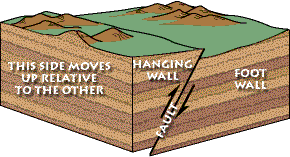Fault The Hanging Wall Moves Down Relative To The Footwall

A downthrown block between two normal faults dipping towards each other is a graben.
Fault the hanging wall moves down relative to the footwall. In a normal fault the hanging wall moves downward relative to the footwall. They bound many of the mountain ranges of the world and many of the rift valleys found along spreading margins. Tension is stress that pulls rocks apart. When the hanging wall moves up in relative to the footwall it is called a fault.
When the hanging wall moves down in relative to the footwall it is called a fault. Normal fault s are common. Along a normal fault the hanging wall moves down relative to the footwall. An upthrown block between two normal faults dipping away from each other is a horst.
Normal fractures in rock with no offset where there has been no motion are called. Normal dip slip faults are produced by vertical compression as earth s crust lengthens. A n fault forms when the hanging wall moves down relative to the footwall a. Another type of fault is the thrust fault where ground on one side of the fault moves up and over adjacent ground.
The hanging wall moves downward relative to the footwall. Normal faults usually form where tectonic plate motions cause tension. Low angle normal faults with regional tectonic significance may be designated detachment faults. A normal fault occurs when the crust is extended.



















